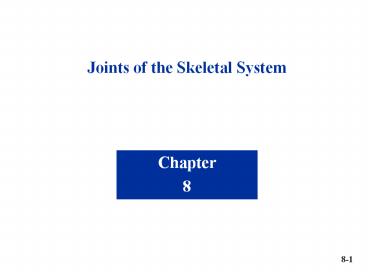PowerPoint to accompany - PowerPoint PPT Presentation
1 / 27
Title:
PowerPoint to accompany
Description:
Title: PowerPoint to accompany Author: Ryan&Regina Hoffman Last modified by: esalper Created Date: 1/14/2003 8:00:03 PM Document presentation format – PowerPoint PPT presentation
Number of Views:111
Avg rating:3.0/5.0
Title: PowerPoint to accompany
1
Joints of the Skeletal System
Chapter 8
8-1
2
Chapter 8Joints of the Skeletal System
- Joints/Articulations
- Junctions between bones
- Ligaments connect bone to bone
- Functions
- Bind parts of skeletal system together
- Enable body to move in response to skeletal
muscle contraction - Make bone growth possible
- Permit parts of the skeleton to change shape
during childbirth
8-2
3
Classification of Joints
- Joint Composition Classification
- Fibrous Joints
- dense connective tissues connect bones
- between bones in close contact
- Movement Classification
- synarthrotic
- immovable
- amphiarthrotic
- slightly movable
- diarthrotic
- freely movable
- Cartilaginous Joints
- hyaline cartilage or fibrocartilage connect bones
- Synovial Joints
- most complex
- Contains synovial fluid
- allow free movement
8-3
4
Fibrous Joints
- 3 Types
- Syndesmosis
- Suture
- Gomphosis
- Syndesmosis
- long fibers connect bones
- amphiarthrotic
- distal ends of tibia and fibula
8-4
5
Fibrous Joints
- Suture
- between flat bones
- synarthrotic
- thin layer of connective tissue connects bones
- Gomphosis
- cone-shaped bony process in a socket
- tooth in jawbone
- synarthrotic
8-5
6
Cartilaginous Joints
- 2 Types
- Synchondrosis
- Symphysis
- Synchondrosis
- bands of hyaline cartilage unite bones
- between manubrium and first rib
- amphiarthrotic
8-6
7
Cartilaginous Joints
- Symphysis
- pad of fibrocartilage between bones
- pubis symphysis
- joint between bodies of vertebrae
- amphiarthrotic
8-7
8
Synovial Joints
- diarthrotic
- joint capsule
- joint cavity
- synovial fluid
- lubrication
- synovial membrane
- bursae
- fluid filled sac
- Cushions/aids movement of tendons over things
8-8
9
Types of Synovial Joints
- Condyloid Joint
- moves up/down left/right
- between metacarpals and phalanges
- Ball-and-Socket Joint
- moves in all directions
- hip
- shoulder
8-9
10
Types of Synovial Joints
- Hinge Joint
- flex/extend
- elbow
- between phalanges
- Gliding Joint
- sliding or twisting
- between carpals
- between tarsals
8-10
11
Types of Synovial Joints
- Pivot Joint
- rotation
- between proximal ends of radius and ulna
- atlas and axis
- Saddle Joint
- back/forth, side/side
- between carpal and metacarpal of thumb
8-11
12
Types of Joint Movements
- abduction/adduction
- dorsiflexion/plantarflexion
- flexion/extension/hyperextension
8-12
13
Types of Joint Movements
- rotation/circumduction
- supination/pronation
8-13
14
Types of Joint Movements
- eversion/inversion
- protraction/retraction
- elevation/depression
8-14
15
Shoulder Joint
- ball-and-socket
- head of humerus
- glenoid cavity of scapula
- loose joint capsule
- bursae
- ligaments prevent displacement
- very wide range of movement
8-15
16
Shoulder Joint
8-16
17
Elbow Joint
- hinge joint
- trochlea of humerus
- trochlear notch of ulna
- gliding joint
- capitulum of humerus
- head of radius
- pivot joint
- radius, ulna
- flexion and extension, rotation
- many reinforcing ligaments
- stable joint
8-17
18
Elbow Joint
8-18
19
Hip Joint
- ball-and-socket joint
- head of femur
- acetabulum
- heavy joint capsule
- many reinforcing ligaments
- less freedom of movement than shoulder joint
8-19
20
Hip Joint
8-20
21
Knee Joint
- largest joint
- most complex
- modified hinge joint
- menisci separate femur and tibia
- medial and lateral condyles of distal end of
femur - medial and lateral condyles of proximal end of
tibia - femur articulates anteriorly with patella
- flexion/extension/little rotation
- strengthened by many ligaments and tendons
- bursae
8-21
22
Knee Joint
8-22
23
Life-Span Changes
- Joint stiffness is an early sign of aging
- Regular exercise can prevent stiffness
- Changes in symphysis joints of vertebral column
diminish flexibility and decrease height - Synovial joints lose elasticity
8-23
24
Sprains
- damage to cartilage, ligaments, or tendons
associated with joints - forceful twisting of joint
25
Bursitis
- inflammation of a bursa
- overuse of a joint
26
Arthritis
- inflamed, swollen, painful joints
- Rheumatoid Arthritis
- Osteoarthritis
- Gout
27
Dislocation
- bones are no longer in their normal position
- joint capsule and ligaments tear
- may be nerve damage































